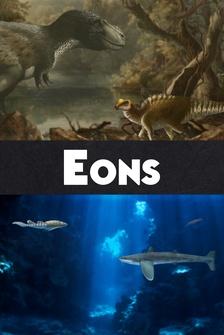- Welcome to 2050.
Nearly every new car manufactured around the world is entirely electric, and 95% of all cars still on the road run on long-range batteries.
Emissions for the entire transportation sector have been reduced by 90% since 2020.
Mixed with emerging carbon capture technologies, the climate trends of the previous century are reversing.
But the forests of Myanmar and Indonesia have been decimated.
Massive radioactive waste ponds devastate ecosystems across China.
Tens of thousands of species have been lost to habitat removal.
Human rights abuses have traumatized entire generations in the Congo, and that's just on the surface, the literal surface.
Meanwhile, 5,000 meters deep, clouds of mud suffocate ocean floors, fragile landscapes formed over millions of years have been extracted, leaving thousands of mysterious unnamed species homeless or extinct.
And beyond our home on Earth, an arms race rages as nations and corporations fight for the right to extract minerals from asteroids, and all that damage in service of the rare metals needed to power clean energy technology.
This is a complicated future, not entirely dystopian, sure, but one where we've made major sacrifices in favor of the clean energy revolution.
But does it have to be that way?
Do we need to plunder the cold depths of the ocean and outer space to get materials to make clean energy possible?
Is there a responsible solution on land, the seas, or the stars?
I'm Sinead Bovell, and this is "Far Out."
[upbeat playful music] Okay, let's introduce some of the key precious metals at the core of our clean energy dilemma: cobalt, manganese, nickel, and lithium.
They dominate electric battery chemistries and are essential to smartphones, HD displays, military drones, you name it.
These elements are currently essential to clean energy.
How rare are they really?
Well, let's take cobalt, which makes up less than 100th of 1% of the Earth's crust.
Sounds tiny, right?
But even that fraction of a percent is dispersed.
Trace amounts exist in many places, but deposits that can actually be mined and refined are incredibly rare.
In fact, 70% of the world's cobalt is mined from the Democratic Republic of Congo, making extraction particularly fraught.
Here's the big thing to keep in mind, demand is growing.
The global supply of lithium needs to increase 42 times by 2050 to meet the demand for electric vehicles.
In the US, nine states have committed to banning gasoline powered vehicles by 2035, and major manufacturers like General Motors plan to only sell zero-emission cars by that same year.
All factors ramping up demand.
So right now, it looks like we need these metals to stave off the climate crisis, especially if we don't wanna give up driving, flying, and our smartphones, but mining them is outrageously bad for people and the planet.
Let's focus on just one example, nickel mining in Indonesia.
One of the islands has seen almost 1.35 million acres of rainforest destroyed since 2011.
That's nearly seven times the land area of New York City, and one refining facility produces roughly 4 million metric tons of toxic waste every year.
Disposal of that material has proven difficult in a landscape surrounded by ocean and prone to heavy rains.
That's just one example.
I haven't mentioned the toll on people.
One study tracked 510 allegations of human rights abuse from 2010 to 2022 in the mining of precious metals.
Yikes, this is the crux of the issue.
Mining is fundamentally not eco-friendly, but the metals that it yields are essential to moving away from fossil fuels.
But what if we could move this dirty mining off the land, like way off the land, and into cold, distant, and difficult places, the deep sea and outer space?
Let's start with space.
Some of the asteroids in our solar systems are estimated to be worth trillions of dollars, which sound absurd, but even if mining these asteroids is possible, we have to first build completely non-existent infrastructure, which could take decades.
Not to mention the economic space race it could trigger, which is its own complex nightmare of who owns outer space.
While I'm excited about the idea of hydrogen-powered spacecraft, snagging payloads of refined nickel and returning to earth, there are some companies that are looking at more of an immediate payoff, the deep ocean.
Let's dive in.
The ocean is big, right?
Like 70% of our planet big.
But the most intense mining focus is on an area of the Pacific Ocean floor between Hawaii and Mexico, the Clarion-Clipperton Zone, or the CCZ.
What makes this area so special?
The ocean floor, on average about 5,000 meters deep, contains the greatest density of polymetallic nodules on the planet.
These nodules look like lumpy black potatoes, and they contain more nickel, manganese, and cobalt than all terrestrial sources combined.
There's no need for digging or detonating this area to free up material.
Instead, it's possible to just suck these rocks up to the surface.
Problem solved, right?
Oh, if only it were that simple.
The metals company based in Canada, as one of the companies leading the push for deep sea mining, they envision a tank-like machine with deep treads that rolls across the ocean floor, scooping the nodules into a pipe and sucking them up to the surface.
You know those automatic vacuums that rove the bottom of pools?
Like that, but the size of a farm combine, and it won't be tidying up.
It will be making a huge unclean mess.
This magical area of the ocean floor is home to a whole ecosystem teaming with life, and we have fantastically little information about its biodiversity, complexity, or connection to the wider ocean.
- The latest surveys estimate that there's something like 5,000 species that live in the CCZ, and 9 outta 10 of them haven't been found anywhere else, and they haven't really had a name given to them yet.
Some of these are big things that you can see with the naked eye that the cameras pick up.
Beautiful octopuses, ghostly pale octopuses hang around here.
They're known to lay their eggs on sponges.
These tall spikes of sponge that grow up rooted on these nodules, these rocks.
- It's not densely populated like a coral reef, but it's wildly diverse, and the nodules themselves, rich with metals, are also riddled with exotic life.
- These rocks, these nodules, are the habitat for amazing diversity of worms and brittle stars.
Those amazing things that if you know about them, you will love called tardigrade, or water bears, these tiny microscopic little creatures that just are adorable under a microscope.
There's all of this hidden life.
- And the whole system may be more fragile than we expected.
A 2020 Japanese study on extracting cobalt showed that after only a two-hour mining test, there was a 43% drop in fish and shrimp density by the following year.
The study also showed a 56% drop in the fish and shrimp density of surrounding areas.
Though to be fair, the research focused on a different kind of mining than the one proposed by the metals company.
But what if we could do some kind of habitat restoration after mining?
Well, that's essentially impossible.
- These take millions of years to form.
I think it's something like 10 million years to go from the size of a pea to a golf ball.
And these things are forming by themselves on the seabed by basically precipitating, taking dissolved metals that are in the water.
They're settling on little hard pieces of substances on the seabed, things like old shark's teeth from millions of years ago, maybe a bit of a whale ear bone, something hard that acts as a nucleus for these, these accretions, really, that are forming around them over very, very slow geological time frames.
I mean, this is one of the slowest geological processes that have been studied on the planet.
- The consensus among marine scientists is clear, we don't know enough to proceed, aka, we probably shouldn't proceed.
But we know strong recommendations from scientists are seldom enough to sway regulation when there is money to be made.
So what's stopping companies from ravaging the ocean floor?
A lot of the "will they" or "won't they" comes down to decisions made by the International Seabed Authority or the ISA.
This is a governing body of 167 member states and the EU, established to help regulate activities on the massive stretches of ocean that don't belong to any country, the so-called high seas.
These areas are treated as shared global heritage, and unlike offshore drilling in areas owned by specific countries, they are much more complicated.
That's one of the reasons most marine scientists and oceanographers hope we'll perceive more cautiously.
- We are all part of this picture.
We're all part of this common, you know, this common heritage, and I think there need to be ways to bring all those voices together.
And we're doing that and we're seeing that.
We are seeing people coming to these ISA meetings.
For instance, the 2023 meetings, we had this incredible influx of indigenous peoples getting together, bringing their voices, specifically indigenous peoples from the Pacific Ocean, who are really on the frontline of where potentially these first mines could happen if it does happen in the CCZ.
They are the closest to where this could be happening.
And they're coming together and they're saying, "We don't want this to happen.
We do not give our permission.
We do not give our blessing for this level of disruption to what we see as our sacred ocean."
And their voices, their views on why this matters to them are being heard and they're getting through.
- There are economic holdouts too.
Companies, including Microsoft, Google, and BMW, have committed to not using deep sea metals until we know more about the environmental impact.
So how do we create an equation for this?
Nations are eager to electrify fleets and abandon fossil fuels as they should be.
But what cost is acceptable?
Are we merely exchanging one known environmental disaster for a lesser known one?
Crucially, there's also zero reason to believe that ocean mining will halt all terrestrial mining.
It might lessen the load, sure, or it may increase competition and urgency, but without regulations in those mines, the activity will continue unabated, hurting multiple ecosystems on land and sea.
There's some reason to hope.
Battery makers are trying to find ways to use less cobalt and nickel with promising results.
But this will take time.
- And the bare minimum on that, which is widely agreed, is that we need at least 10 years to go and do the research that's necessary.
- So what does 10 years buy us?
Well, I hope it buys us a few things.
Time to sort out regulations on terrestrial mining to be more sustainable and ethical, time to develop a realistic timeline for asteroid mining, time for scientists to convince regulators we may be walking into the next planetary catastrophe by mining the ocean floor, and time for those of us who want to protect the planet to join the cause.
[gentle upbeat music]















